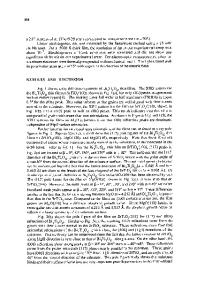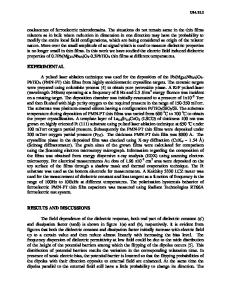Structural and Dielectric Properties of Pulsed Laser Deposited Pb[Yb 1/2 Nb 1/2 ]O 3 -PbTiO 3 Thin Films
- PDF / 975,067 Bytes
- 6 Pages / 415.8 x 637.2 pts Page_size
- 21 Downloads / 261 Views
PROPERTIES
OF PULSED
LASER
DEPOSITED
Wronique BORNAND* and Susan TROLIER-McKINSTRY The Pennsylvania State University, Department of Materials Science and Engineering, Materials Research Laboratory, University Park, PA 16802-4801 *current address : Laboratoire de Physicochimie de la Mati~re Condens~e UMR 5617, C.C. 003, Place Eugene Bataillon, 34095 MONTPELLIER C&dex 5,France ABSTRACT
Heterostructures consisting of (001) LaAIO 3 or (111) SrTiO 3 substrates, SrRuO 3 metallic oxide bottom electrodes and Pb[Ybl/ 2Nb,/21O 3-PbTiO 3 ferroelectric films were deposited by pulsed laser deposition. The combination of oxidic perovskite-type materials results in highly - or -heteroepitaxial capacitors with well-defined and homogeneous columnar microstructures. Most of the films show room temperature dielectric constant greater than 1500 associated with low dielectric loss (tg6" < 4%) and exhibit saturated hysteresis loops with remanent polarizations up to Pr - 50ptC.cm 2 . It was found that the ferroelectric characteristics and, in particular, the fatigue phenomena greatly depend on the orientation and crystalline quality of the as-grown films. The stabilization of the -orientation enhances the fatigue resistance and a good endurance up to 1011 cycles has been determined for highly textured samples. In contrast, fatigue tests performed on strongly -oriented capacitors have revealed poor fatigue performances, with a progressive decrease in the switchable polarization by ac voltage cycling. INTRODUCTION
The last decade has seen a surge of interest in ferroelectric thin films due to their potential integration in a wide range of capacitive applications and microelectromechanical systems (MEMS). ' 2 In particular, considerable attention has been recently paid to the preparation of high-quality epitaxial relaxor ferroelectric thin films to take full advantage of their anisotropic properties. Indeed, the demonstration of high strains, high piezoelectric coefficients and high electromechanical coupling constants in relaxor ferroelectric single crystals of the Pb[B'B"103PbTiO 3 family suggests that the development of judiciously-oriented lead-based relaxor-PbTiO 3 thin films could improve the reliability and performances of existing devices. 36 Of the reported relaxor ferroelectric-PbTiO3 solid solutions, (l-x) Pb[Yb,/ 2Nb1 /2 ]O3 - x PbTiO 3 (PYbN-PT) has the highest transition temperature (-360'C) at the morphotropic phase boundary (MPB x-0.5). 7.8 This should greatly improve the high temperature capabilities of piezoelectric driven MEMS relative to lead magnesium niobate-based compounds. Thus, this study focuses on the preparation and characterization of heteroepitaxial PYbN-PT thin films with 50:50 and 60:40 compositions. EXPERIMENTAL PROCEDURE
PYbN-PT thin films with SrRuO 3 (SRO) bottom electrodes were sequentially deposited by the pulsed laser deposition (PLD) process onto pseudo-cubic -oriented LaAIO 3 (LAO) and -oriented SrTiO 3 (STO) substrates. Details of the specific processing conditions and device optimizations fo
Data Loading...











